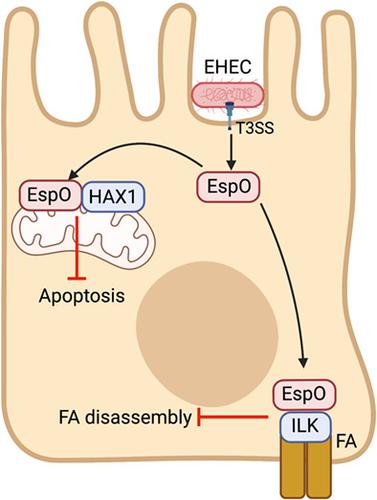当前位置:
X-MOL 学术
›
Cell. Microbiol.
›
论文详情
Our official English website, www.x-mol.net, welcomes your
feedback! (Note: you will need to create a separate account there.)
The type III secretion system effector EspO of enterohaemorrhagic Escherichia coli inhibits apoptosis through an interaction with HAX-1
Cellular Microbiology ( IF 2.6 ) Pub Date : 2021-05-22 , DOI: 10.1111/cmi.13366 Sharanya Chatterjee 1 , Sujinna Lekmeechai 1 , Nicolas Constantinou 1 , Ewa A Grzybowska 2 , Zuzanna Kozik 3 , Jyoti S Choudhary 3 , Cedric N Berger 1 , Gad Frankel 1 , Abigail Clements 1
Cellular Microbiology ( IF 2.6 ) Pub Date : 2021-05-22 , DOI: 10.1111/cmi.13366 Sharanya Chatterjee 1 , Sujinna Lekmeechai 1 , Nicolas Constantinou 1 , Ewa A Grzybowska 2 , Zuzanna Kozik 3 , Jyoti S Choudhary 3 , Cedric N Berger 1 , Gad Frankel 1 , Abigail Clements 1
Affiliation

|
Many enteric pathogens employ a type III secretion system (T3SS) to translocate effector proteins directly into the host cell cytoplasm, where they subvert signalling pathways of the intestinal epithelium. Here, we report that the anti-apoptotic regulator HS1-associated protein X1 (HAX-1) is an interaction partner of the T3SS effectors EspO of enterohaemorrhagic Escherichia coli (EHEC) and Citrobacter rodentium, OspE of Shigella flexneri and Osp1STYM of Salmonella enterica serovar Typhimurium. EspO, OspE and Osp1STYM have previously been reported to interact with the focal adhesions protein integrin linked kinase (ILK). We found that EspO localizes both to the focal adhesions (ILK localisation) and mitochondria (HAX-1 localisation), and that increased expression of HAX-1 leads to enhanced mitochondrial localisation of EspO. Ectopic expression of EspO, OspE and Osp1STYM protects cells from apoptosis induced by staurosporine and tunicamycin. Depleting cells of HAX-1 indicates that the anti-apoptotic activity of EspO is HAX-1 dependent. Both HAX-1 and ILK were further confirmed as EspO1-interacting proteins during infection using T3SS-delivered EspO1. Using cell detachment as a proxy for cell death we confirmed that T3SS-delivered EspO1 could inhibit cell death induced during EPEC infection, to a similar extent as the anti-apoptotic effector NleH, or treatment with the pan caspase inhibitor z-VAD. In contrast, in cells lacking HAX-1, EspO1 was no longer able to protect against cell detachment, while NleH1 and z-VAD maintained their protective activity. Therefore, during both infection and ectopic expression EspO protects cells from cell death by interacting with HAX-1. These results suggest that despite the differences between EHEC, C. rodentium, Shigella and S. typhimurium infections, hijacking HAX-1 anti-apoptotic signalling is a common strategy to maintain the viability of infected cells.
中文翻译:

肠出血性大肠杆菌的III型分泌系统效应子EspO通过与HAX-1相互作用抑制细胞凋亡
许多肠道病原体利用 III 型分泌系统 (T3SS) 将效应蛋白直接转移到宿主细胞的细胞质中,从而破坏肠上皮的信号传导途径。在此,我们报道抗凋亡调节因子 HS1 相关蛋白 X1 (HAX-1) 是肠出血性大肠杆菌(EHEC) 和啮齿类柠檬酸杆菌的 T3SS 效应子 EspO、福氏志贺氏菌的 OspE 和肠沙门氏菌的 Osp1 STYM的相互作用伴侣。鼠伤寒血清型。此前已报道 EspO、OspE 和 Osp1 STYM与粘着斑蛋白整合素连接激酶 (ILK) 相互作用。我们发现 EspO 定位于粘着斑(ILK 定位)和线粒体(HAX-1 定位),并且 HAX-1 表达的增加导致 EspO 线粒体定位增强。 EspO、OspE 和 Osp1 STYM的异位表达可保护细胞免受星形孢菌素和衣霉素诱导的细胞凋亡。消耗 HAX-1 的细胞表明 EspO 的抗凋亡活性是 HAX-1 依赖性的。使用 T3SS 传递的 EspO1 感染期间,HAX-1 和 ILK 均被进一步证实为 EspO1 相互作用蛋白。使用细胞脱离作为细胞死亡的代表,我们证实 T3SS 传递的 EspO1 可以抑制 EPEC 感染期间诱导的细胞死亡,其程度与抗凋亡效应器 NleH 或泛 caspase 抑制剂 z-VAD 治疗相似。相反,在缺乏HAX-1的细胞中,EspO1不再能够防止细胞脱离,而NleH1和z-VAD则保持其保护活性。因此,在感染和异位表达期间,EspO 通过与 HAX-1 相互作用来保护细胞免于细胞死亡。 这些结果表明,尽管 EHEC 之间存在差异, C .啮齿目动物、志贺氏菌和沙门氏菌。在鼠伤寒感染中,劫持 HAX-1 抗凋亡信号是维持受感染细胞活力的常见策略。
更新日期:2021-05-22
中文翻译:

肠出血性大肠杆菌的III型分泌系统效应子EspO通过与HAX-1相互作用抑制细胞凋亡
许多肠道病原体利用 III 型分泌系统 (T3SS) 将效应蛋白直接转移到宿主细胞的细胞质中,从而破坏肠上皮的信号传导途径。在此,我们报道抗凋亡调节因子 HS1 相关蛋白 X1 (HAX-1) 是肠出血性大肠杆菌(EHEC) 和啮齿类柠檬酸杆菌的 T3SS 效应子 EspO、福氏志贺氏菌的 OspE 和肠沙门氏菌的 Osp1 STYM的相互作用伴侣。鼠伤寒血清型。此前已报道 EspO、OspE 和 Osp1 STYM与粘着斑蛋白整合素连接激酶 (ILK) 相互作用。我们发现 EspO 定位于粘着斑(ILK 定位)和线粒体(HAX-1 定位),并且 HAX-1 表达的增加导致 EspO 线粒体定位增强。 EspO、OspE 和 Osp1 STYM的异位表达可保护细胞免受星形孢菌素和衣霉素诱导的细胞凋亡。消耗 HAX-1 的细胞表明 EspO 的抗凋亡活性是 HAX-1 依赖性的。使用 T3SS 传递的 EspO1 感染期间,HAX-1 和 ILK 均被进一步证实为 EspO1 相互作用蛋白。使用细胞脱离作为细胞死亡的代表,我们证实 T3SS 传递的 EspO1 可以抑制 EPEC 感染期间诱导的细胞死亡,其程度与抗凋亡效应器 NleH 或泛 caspase 抑制剂 z-VAD 治疗相似。相反,在缺乏HAX-1的细胞中,EspO1不再能够防止细胞脱离,而NleH1和z-VAD则保持其保护活性。因此,在感染和异位表达期间,EspO 通过与 HAX-1 相互作用来保护细胞免于细胞死亡。 这些结果表明,尽管 EHEC 之间存在差异, C .啮齿目动物、志贺氏菌和沙门氏菌。在鼠伤寒感染中,劫持 HAX-1 抗凋亡信号是维持受感染细胞活力的常见策略。











































 京公网安备 11010802027423号
京公网安备 11010802027423号